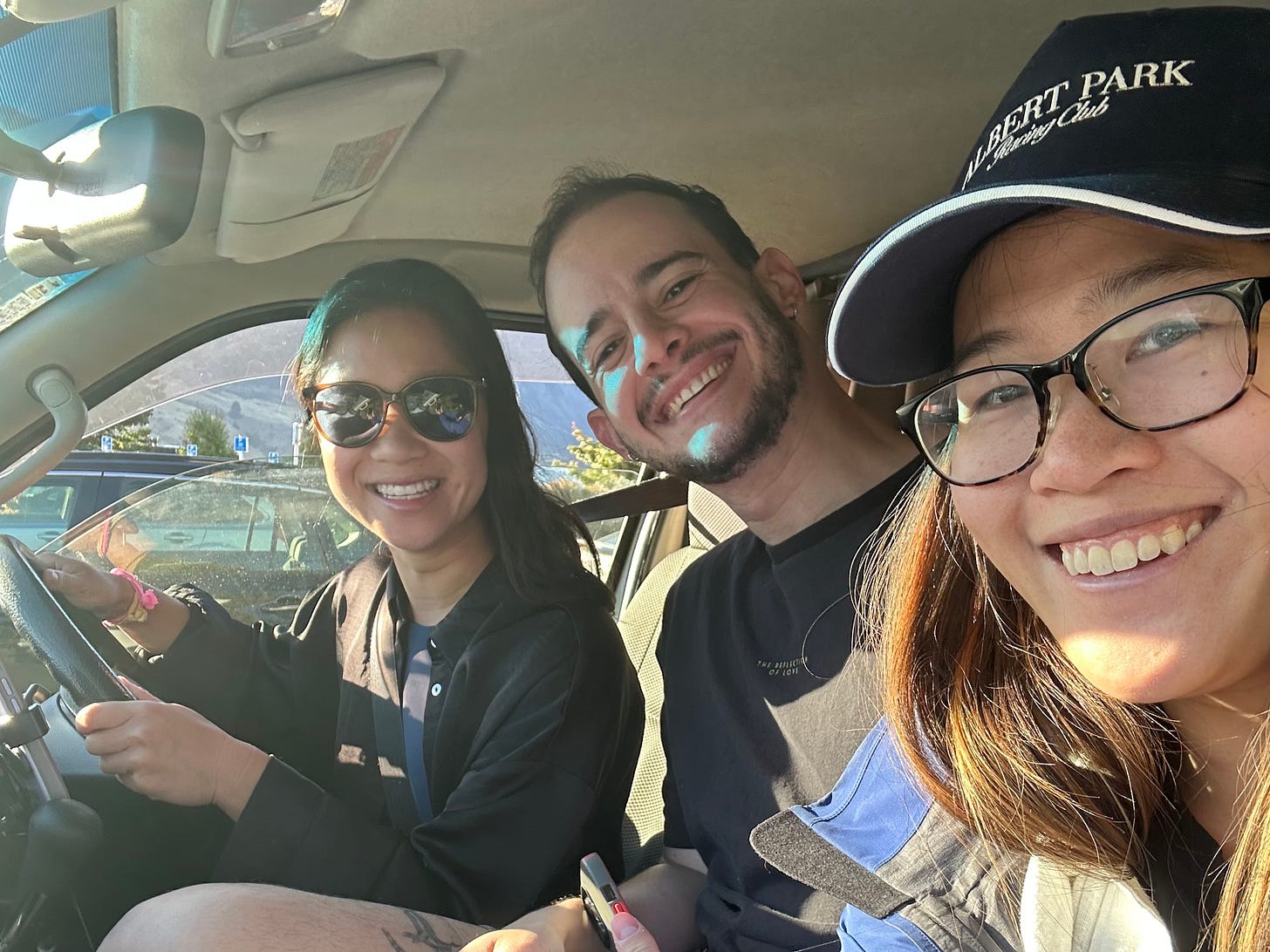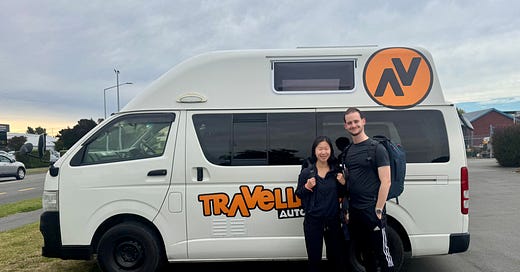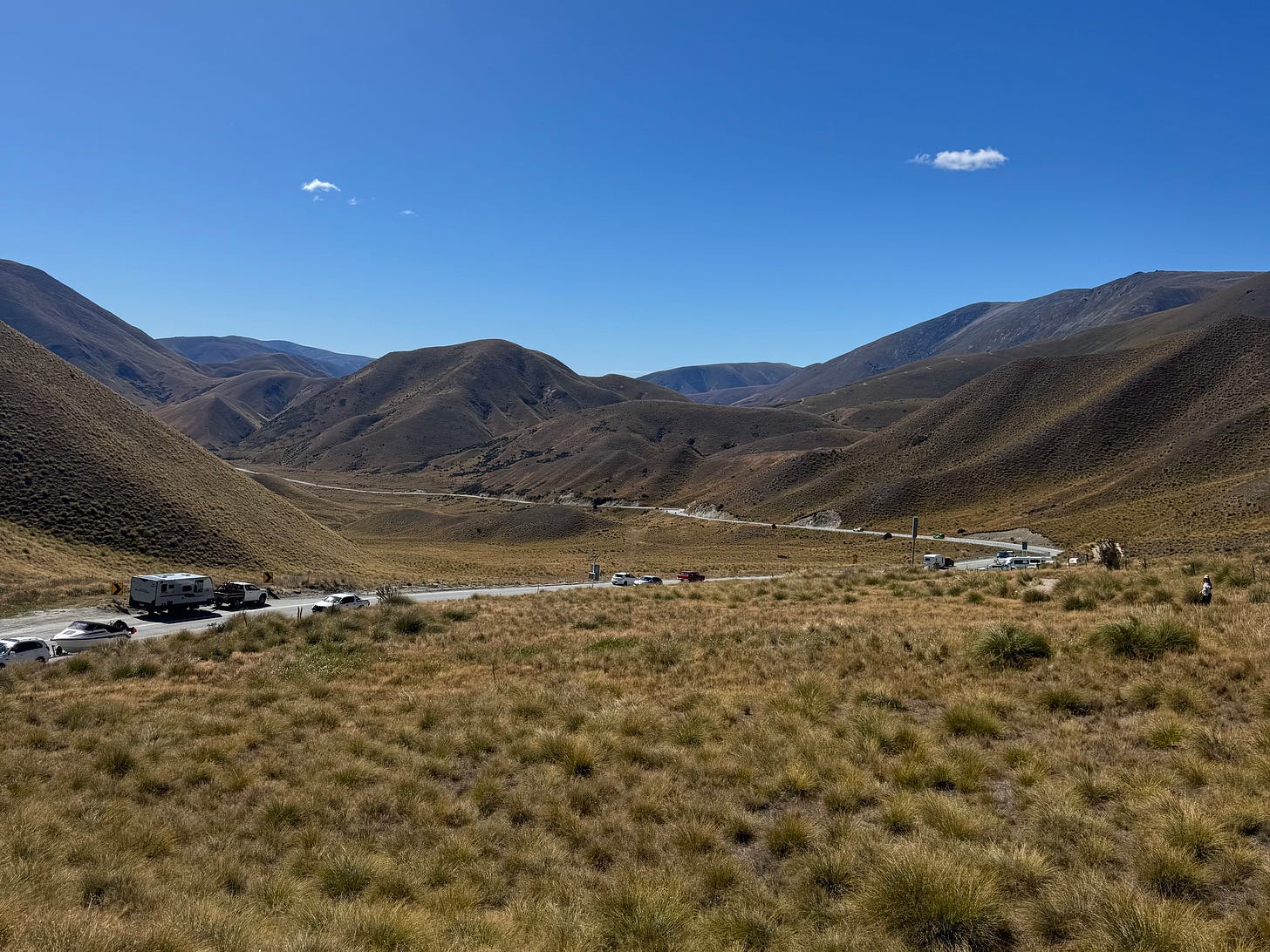Home Is Where You Park It: Two Weeks of Van Life in New Zealand
Beyond the Instagram ideal: The reality of two weeks on wheels.
Hello from Kangaroo Valley! We’ve been road-tripping around the Sydney area and will have plenty to share, but we are still catching up on the New Zealand content. It’s weird to be writing about van life today, having had consistent access to hot showers and reliable electricity (which we have newfound appreciation for) over the last few days. Time is moving oddly fast and slow at the same time—New Zealand feels like it was months ago!
While our epic hikes defined our daytime activities on New Zealand’s South Island, it was our camper van that truly shaped our experience. For two weeks, we lived in what was essentially a bedroom, kitchen, and living room combined into 50 square feet on wheels. Here's what we learned about tiny home living while covering 2,500+ kilometers of stunning landscape.
P.S. We made an Instagram Reel to complement this article.
Our Tiny Convertible Home
We chose a mid-tier van from Travellers AutoBarn after extensive research (they had the best reviews). Reviews of some of the other options were a bit… terrifying. It wasn't the most luxurious option, but it was sufficient for two people with minimal expectations. The more luxurious options also tend to be far larger, and Claire and I both had minimal experience driving these things (foreshadowing).
Our home featured one convertible space with three configurations: lounging, dining, and sleeping. Converting between these modes was my responsibility, initially taking 15-20 minutes but down to under five by trip's end. Storage was all underneath the seating areas, making retrieval of clean clothes while in bed mode a contortionist exercise.
Driving Champion of the Year
The most surprising development? Claire becoming our exclusive driver for the entire trip—all 40+ hours and 2,500+ kilometers. This deserves big recognition.
I was the one who booked the van, assuming we'd share the driving, but it became clear within the first hour that I wasn't adept at keeping the massive vehicle between the lines on narrow roads. Claire, slightly better at the start, took over completely and improved dramatically over the two weeks.
Wind proved particularly challenging, requiring Claire to drive against it. Seeing the wheel turned at an angle while the van was moving straight was a sight to behold. We'd feel the van swaying in strong gusts, which was terrifying for both driver and passenger.
Then came our most embarrassing moment. After crawling uphill at barely 30 km/h for the first few days and being passed by virtually every vehicle (huge trucks were particularly demoralizing), we finally called customer service to ask if something was wrong.
"Have you tried using D2?" they asked.
Yes, somehow, two educated adults with degrees failed to consider that those other numbers on the gearshift might serve a purpose. After this revelation, hills became manageable, though cars still zoomed past us regularly.
The most challenging driving came on the Lindis Pass—a mountain route with fierce crosswinds. Navigating this in daylight was difficult, but crossing it in complete darkness on our final night elevated it to new levels of stress.
My Life as a Passenger Princess
While Claire mastered driving, I settled into my role with several responsibilities:
Yelling "cowies!" or "sheepies!" whenever we passed a farm (approximately every five minutes in New Zealand)
DJing our road trip soundtrack, heavy on Dua Lipa in preparation for the Sydney concert and, unexpectedly, Maroon 5. She Will be Loved became the anthem of the road trip for sure.
Cooking duties once we parked (maintaining our NYC division of labor where Claire handles cleaning).
Despite the compact kitchen, cooking was surprisingly enjoyable. The stove required turning on an external gas container and lighting with a match, which felt adventurous the first few times. We kept meals simple: pastas, steaks, salads, eggs, and the highlight—salmon purchased from High Country Salmon in Twizel, enhanced by our trusty jar of Lao Gan Ma chili crisp.
Campsites: Powered vs. Unpowered
Our nights split between powered and unpowered sites, with one experiment in "freedom camping" (basically a parking lot with toilets).
Powered sites ($30ish USD per night) became our preferred option because they allowed us to charge devices, use the microwave, and most importantly, run our portable heater—crucial when temperatures dropped. At unpowered sites ($10ish per night), we'd often wake up shivering in the middle of the night.
The bathroom situation involved getting fully dressed, noisily opening and closing the van door, and inevitably waking each other. We mastered strategic hydration, limiting water intake before bed. The van did have an emergency toilet, but we were advised to avoid using it unless there was an emergency—there wasn’t.
Memorable locations included:
Oamaru Harbor Tourist Park, where blue penguins nested (featured in a previous newsletter).
The Camp, a lakeside spot by Lake Hawea (near Wānaka) where we spent three nights for its excellent facilities.
The Milford Sound Lodge, the only one that required booking in advance and the most expensive, but definitely the nicest. Wekas and Keas galore.
Sleep: The Surprising Upside
Despite the setup required and the fairly thin cushioning, we slept remarkably well. With limited internet access and few entertainment options after dark, we often fell asleep by 9-10 PM and woke up around 9-10 AM, consistently getting 10-12 hours. On the night that we freedom camped, there was nothing to do once the sun went down, so we slept from 7 PM to 8 AM—a luxurious 13 hours!
This unexpected benefit—disconnecting from screens and reconnecting with natural sleep rhythms—was something we didn't anticipate but greatly appreciated.
Our Friend Amy's Visit
Having Amy join us for two nights provided a welcome change after 2.5 weeks of just us two. While we obviously enjoy spending time together (or we wouldn't have committed to a year of travel!), having new energy refreshed us both.
Setting up the third bed on top of the van wasn't as complicated as feared, but three people in our modest van definitely pushed the limits of comfort. Perfect for a short visit, but confirming our two-person setup was ideal for longer periods. In Amy’s own words:
“It was a very intimate gathering of friends, but felt like a huge sleepover. Super creative use of space. Everything had dual purposes. Nothing is secret in the van, if someone turns over the car rocks.”

The Freedom Premium
Financially, the camper van experience was probably a bit more expensive than renting a standard car and staying in budget accommodations. The van rental wasn't cheap, gas became a major expense (refueling after every 2-3 hours of driving), and campsite fees added up.
But the freedom was worth every dollar. We could (and did) change plans based on weather forecasts, stay longer in places we loved, and wake up already at trailheads for sunrise hikes. The flexibility was invaluable.
Would We Do It Again?
Both of us would recommend a New Zealand camper van experience without hesitation—but with one caveat: two weeks was probably our limit. A week would be the sweet spot for future van adventures.
By the end, we were desperate to return to a life of daily showers and on-demand electricity. That said, the experience gave us a deeper appreciation for the comforts we typically take for granted.
There was also something special about waving excitedly to fellow Travelers AutoBarn vans on the road (their cars all carry a massive logo) and feeling part of a community of adventurers navigating narrow roads, mountain passes, and the occasional confused sheep crossing.
While hiking may have given us our most spectacular views in New Zealand, our little van gave us our home. For two weeks, we cooked, slept, laughed, problem-solved, and grew closer in our tiny home on wheels. It wasn't always Insta-worthy—sometimes it was downright freezing—but like most challenges on this year-long adventure, it's the experiences that push us slightly outside our comfort zones that will create the most lasting memories.
Up next: Region recap #2 (#1 was for the North Island) covering the South Island of New Zealand, focusing on the non-hiking, non-van life highlights that made our two weeks there unforgettable. Stay tuned!









